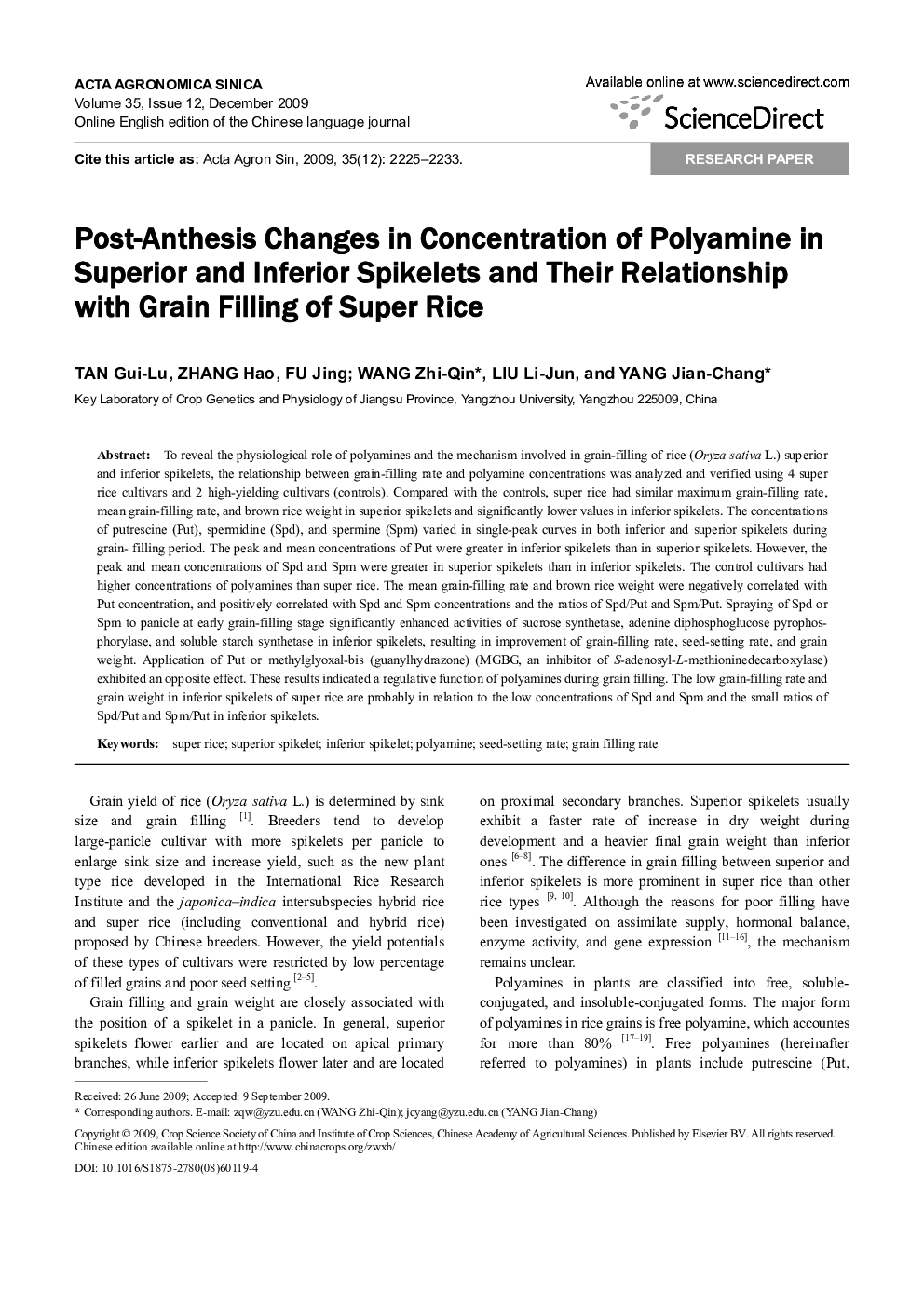| Article ID | Journal | Published Year | Pages | File Type |
|---|---|---|---|---|
| 4503285 | Acta Agronomica Sinica | 2009 | 9 Pages |
To reveal the physiological role of polyamines and the mechanism involved in grain-filling of rice (Oryza sativa L.) superior and inferior spikelets, the relationship between grain-filling rate and polyamine concentrations was analyzed and verified using 4 super rice cultivars and 2 high-yielding cultivars (controls). Compared with the controls, super rice had similar maximum grain-filling rate, mean grain-filling rate, and brown rice weight in superior spikelets and significantly lower values in inferior spikelets. The concentrations of putrescine (Put), spermidine (Spd), and spermine (Spm) varied in single-peak curves in both inferior and superior spikelets during grain-filling period. The peak and mean concentrations of Put were greater in inferior spikelets than in superior spikelets. However, the peak and mean concentrations of Spd and Spm were greater in superior spikelets than in inferior spikelets. The control cultivars had higher concentrations of polyamines than super rice. The mean grain-filling rate and brown rice weight were negatively correlated with Put concentration, and positively correlated with Spd and Spm concentrations and the ratios of Spd/Put and Spm/Put. Spraying of Spd or Spm to panicle at early grain-filling stage significantly enhanced activities of sucrose synthetase, adenine diphosphoglucose pyrophosphorylase, and soluble starch synthetase in inferior spikelets, resulting in improvement of grain-filling rate, seed-setting rate, and grain weight. Application of Put or methylglyoxal-bis (guanylhydrazone) (MGBG, an inhibitor of S-adenosyl-L-methioninedecarboxylase) exhibited an opposite effect. These results indicated a regulative function of polyamines during grain filling. The low grain-filling rate and grain weight in inferior spikelets of super rice are probably in relation to the low concentrations of Spd and Spm and the small ratios of Spd/Put and Spm/Put in inferior spikelets.
摘 要以4个超级稻品种[两优培九和II优084(杂交籼稻)、淮稻9号和武粳15(粳稻)]为材料, 2个高产品种[汕优63(杂交籼稻)、扬辐粳8号(粳稻)]为对照, 测定了结实期强、弱势粒中腐胺(Put)、亚精胺(Spd)和精胺(Spm)浓度和灌浆速率, 分析了它们之间的关系, 并用化学调控的方法进行了验证。结果表明, 强势粒的最大灌浆速率、平均灌浆速率和糙米重, 超级稻品种与对照品种差异较小, 弱势粒的灌浆速率和粒重表现为超级稻品种显著低于对照品种。灌浆期强、弱势粒的Put、Spd和Spm浓度变化均成单峰值曲线。Put的峰值浓度和平均浓度, 弱势粒高于强势粒。Spd和Spm峰值浓度和平均浓度, 弱势粒显著低于强势粒, 超级稻品种低于对照品种。籽粒平均灌浆速率和糙米重与Put浓度呈极显著负相关, 与Spd和Spm浓度以及Spd/Put和Spm/Put呈极显著正相关。灌浆初期对稻穗喷施Spd和Spm, 增强了弱势粒中蔗糖合成酶、ADP葡萄糖焦磷酸化酶和可溶性淀粉合成酶活性, 提高了弱势粒灌浆速率、结实率和粒重, 喷施Put或多胺合成抑制剂(MGBG)的结果则相反。说明多胺参与水稻籽粒灌浆的调控, 超级稻品种弱势粒较低的Spd和Spm浓度及较低的Spd/Put和Spm/Put值是其灌浆速率小、粒重轻的一个重要生理原因。
